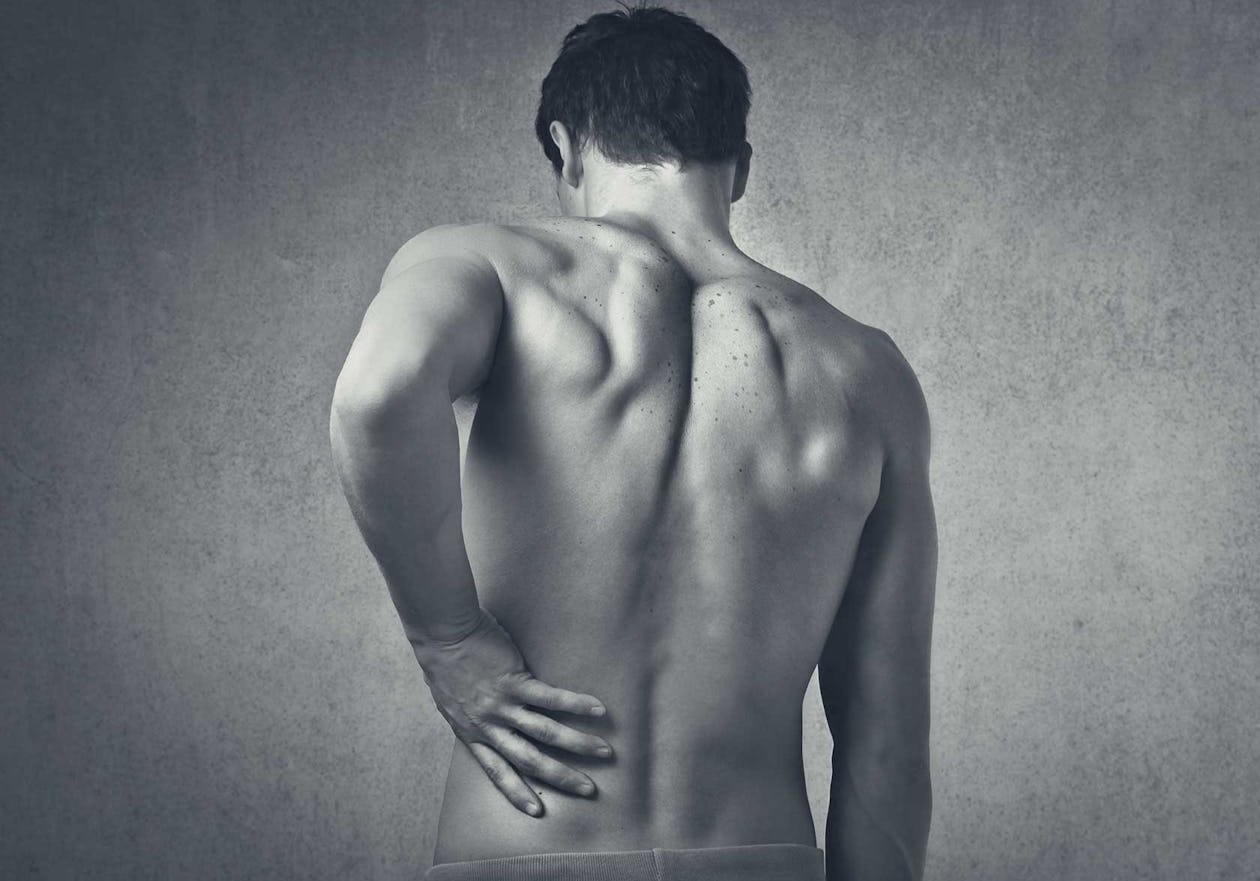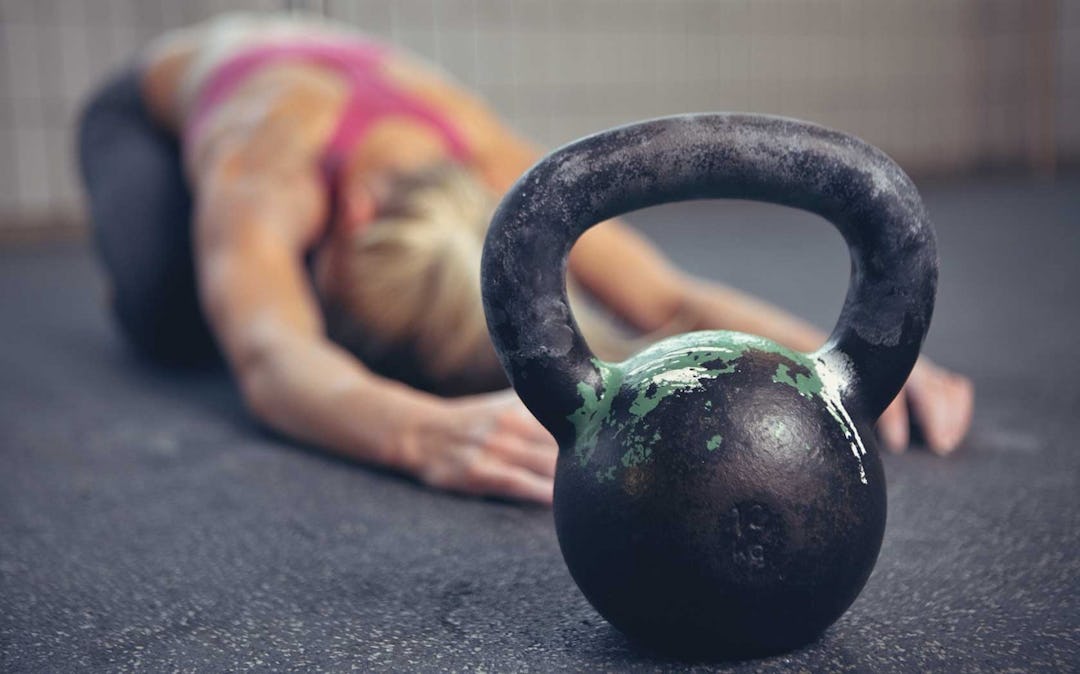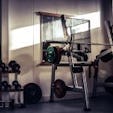If your kettlebell lifting is causing back soreness, there may be a few things to look at and some effective habits to put into practice to help address it.
I like to keep things simple, but often in the real world simple things can also be complex, interconnected, and painful.
If you plug one hole in a system, it may magnify another weak link. Likewise, fixing something on one end of that system might just improve the entire performance of the system.
The body is excellent at attempting to find balance, a kind of homeostasis that will have it function and perform, often at the expense of something somewhere.
It’s excellent at compensating, at “handing” faulty movement patterns, until it can’t handle them anymore.
Something breaks, an injury occurs, you can’t do what you love to do, and all your hard training won’t matter. It takes time and patience to master something.
Don’t be a fool and rush in thinking things like mobility work is a waste of time. Some of the smallest things often have the biggest impact.
I’ll address three possible reasons for back soreness and pain, and offer some ways to fix it. These come from my experience but is in no way an exhaustive list of what may be the cause or the absolute do’s and don’ts.
I always try to apply things on an individual basis and essentially stick with what gets the result you want. Simply put if you put it into practice and it works stick to it.
Something different may work for you, but not for someone else. Or it may take longer for someone else to progress.
If you’re experiencing seriously chronic pain with your lifting, don’t be a fool get your ass to a chiropractor, physical therapist, movement specialist, or active release/massage therapist! Then get a qualified coach. Why Kettlebell lifting is hurting your back:
Kettlebell Back Pain Cause #1: Your Technique Sucks

Low back pain is a common complaint in Kettlebell sport, in particular for beginners. One example, and an essential move is learning the swing, (one hand of course!) Low back pain can be simply from what I call “chasing the bell”.
This is a technique issue. Letting the kettlebell get out away from your body, off your midline, essentially pulling you forward even as much to feel your weight on your toes, then yanking it up out of the back swing, can cause considerable stress on the lower back.
Swing Low
The key is feeling you and the Kettlebell as a system. The load must be kept over your base (mid-foot or towards the front of your heel), so your weight is always towards the heels, always on your midline.
The back swing should allow for the Kettlebell to finish its natural arc, as your body moves with the kettlebell, with your arm completely relaxed the whole time. The upswing is all leg drive and momentum, (think about jumping backward) again keeping the weight over your base.
You should get a natural lean back of your torso as the Kettlebell swings up from the force of your leg drive, and your arm is relaxed and long. As the bell begins to drop, move your body with the kettlebell absorbing the weight with your body.
Clean It Up
After mastering the swing, being able to clean the Kettlebell into a comfortable rack position is critical, and it also takes practice and patience.
Back pain can creep up from not feeling the relaxation and tension needed to find the perfect rack position, or simply not having the mobility to get the Kettlebell on the hip.
The rack position: legs straight, hips forward, shoulders down and elbows low. These are critical so that the load passes through your elbow and hip-joint, though the center of your base.
Don’t be in a hurry to push around heavy Kettlebells and don’t rush your swing, clean and rack work. I’ve seen lifters progress too quickly, only to have to backtrack and clean up their technique after an injury or an inability to handle increased volume or a heavier bell.
It’s a good idea to be able to clean the Kettlebell and hold the rack position for 10 seconds before putting theKettlebells over your head!
Hands Overhead!
The overhead position is where more low back pain issues bear their ugly head. If you’re in a hurry to load overhead without the mobility, stability, and strength to do so, all hell will break loose eventually.
I see this with the inability to fixate (more on this another time!) the Kettlebell overhead with the kettlebell, shoulder joint, hip joint and mid-foot alignment. Instead, you may be leaning back with lumbar extension, with the Kettlebell out in front of your shoulder joint, and elbow bent.
You could get away with this with light loads, but even light loads will kill your back and shoulders over multiple reps. Another common technique error is too much tension in your deltoids caused by rotating the thumbs inward in the overhead position.
Making sure the Kettlebell handle is at about 45 degrees overhead with thumbs pointing back a bit, the handle resting on the heel of your palm and your fingers relaxed, will help your structure handle the load more efficiently.
So what do you do about your sucky technique? Get a qualified coach; seek out the organizations that know their stuff and practice. Put your time in with proper technique, always quality over quantity and progression may be slow but solid as hell.
But wait! Getting a coach and practicing proper technique seems like an obvious fix, but what if you just can’t get your shoulders in a sound overhead position no matter how loud your coach yells at you? That brings us to¦
Kettlebell Back Pain Cause #2. Your Mobility is Crap

For Kettlebell sport, the ultimate goal is to get the bell overhead. Many, many times. If you’ve trained for and have plenty of 10 minute sets under your belt, you can begin to grasp the importance of healthy shoulders and a healthy back.
It might not occur to some, that for seasoned lifters, years of competing may not be all that healthy if mobility and asymmetries are not taken care of.
Mobility must be created and maintained in order to set up the opportunity for continued stabilization and ultimately strength and stamina.
Your Shoulders
Stacking weight overhead without shoulder mobility can be a recipe for disaster. That is, you will get some progress out of your presses and jerks, but you will ultimately have to, at some point, stop and deal with your limitations.
What’s worse is that you will have wasted time, will probably have to unlearn faulty movement, and pretty much start over.
The proper alignment for an overhead position should allow you to visually draw a line through the center of the Kettlebell, your shoulder joint, hip joint, and mid foot. The inability to get in that position may be due to a tight upper back, neck and shoulders.
You have to gain flexibility, release tight rotator cuff, lats, traps, and neck muscles. We use Active Release Therapy, the Big Stick, and Wall Slides-a mobility favorite from Michael Boyle.
Your Upper Back
Shoulder mobility can limit your ability to load overhead, and your upper back mobility-thoracic mobility-may be to blame as well. We want thoracic extension and rotation. The unfortunate “sit on your ass I in a desk since 1st-grade syndrome” may be against most of us.
I will often see extensive lordosis in the lower back (your tail tips up and your belly pooches out), a forward head posture, and rounded shoulders.
The ability for the spine to distribute load efficiently relies on your back, as a system being able to have the mobility and stability where it is supposed to be, and it is greatly limited by this dysfunctional posture.
Thoracic spine mobility can be gained with the foam roller, lacrosse balls, the Big Stick, and exercises like light barbell behind the neck presses. My go t’s include several T-spine mobility techniques like the partner push pull from Gray Cook.
Your Hips
Tight hip flexors can also cause low back pain. The psoas, and the iliacus are powerful hip flexors that pull on your pelvis, causing it to tilt forward (this is that tail tipping up and belly pooching out position again) .
This causes your hamstrings to lengthen or lockout long—making them harder to strengthen by the way! And this causes an increase of lordosis in the low back, causing that forward head posture and related shoulder issues.
We foam roll, stretch, and add hip mobility to the program every day. One favorite stretch of mine is a simple quad stretch from Paul Chek.
Another excellent resource we use for all mobility issues is MobilityWOD.com.
But it doesn’t end there. This mobility recipe for disaster usually also means that your abdominals AND your low back are weak as hell. If you spend a lot of time addressing your mobility limitations like a mad person— this can look like only 10-15 minutes EVERY DAY you will reap the benefits!
So what’s the nest step you ask? Strength of course! And strength matters because the stronger athlete will always win, period. So let’s shed some light on the next possible cause for your low back pain.
Kettlebell Back Pain Cause #3: You Are Unstable & Weak

Your Lower Back is Weak
We get quality over quantity-slow the hell down in your training and master the proper techniques. And we get mobility before stability and strength because mobility is the foundation upon which an opportunity for stabilization and strength exists.
Remember, the body is good at compensating (this could also be seen as adapting) and overcoming imbalances. When it comes to your back being an ideal system, your low back; the lumbar spine should be stable, and your upper back; the thoracic spine should be mobile.
If there is a lack of integrity anywhere along this system such as immobility in the thoracic spine, the compensation can cause a hypermobile (and weak) low back. This instability can cause lower back pain and load bearing overhead might hurt you.
To fix this, work in some thoracic spine mobility every day and strengthen your low back. For back strength we focus regularly on overall strength training with Barbell squats, Deadlifts, good mornings, and back extensions.
These strength exercises are also great for increasing range of motion and symmetry. By the way, proper kettlebell lifting technique – swings and jerks – will strengthen and align your spine.
Your Shoulders are Weak
Your overhead position will be unstable and weak if you have mobility and alignment issues—the excess lordosis, forward head posture, and tight muscles in your hips, chest, and shoulders.
What you want is the ability to pack your shoulder, and stabilize a load, and maintain vertical proprioception. That’s a fancy word for your muscles and joints ability to right itself, stabilize, react and interact with the outside world.
Use corrective exercises, stretches, and strength exercises to target your weaknesses. I call this “tightening up the nuts and bolts” on your most prized machine your body.
This means greasing the grooves with sound movement patterns, incremental progressive loading, and conscious gradual progress. The purpose of corrective exercise is to magnify whatever your weak links.
One example of an exercise that can help you fix your weak shoulders is the arm bar. We use the arm bar as one of many prep exercises for a healthy, stable shoulder, and everyone gets what they need out of it.
The key is vertical stability, and the ability to keep your shoulder stable while in motion. The Kettlebell is the best tool for the armbar because of the offset center.
The arm bar will not only mobilize the shoulder by stretching the chest muscles, but will strengthen the stabilizer muscles in the shoulder, increase thoracic mobility, and build shoulder strength in all ranges of motion.
Lower back soreness can be greatly reduced by gaining mobility, stability, and strength in the shoulder. It is best used along with other exercises and techniques that increase range on motion and strength in the hips and upper back.
How to Perform The Arm Bar:
Here are some sample practices we put into daily preparation for shoulder mobility and stability, and thoracic mobility and lower back strength for our kettlebell lifters.
These practice preps are performed before prescribed working sets, whether it be a strength, interval, or competition focused practice. Consistency is key to getting results, and these can be done every day and should only take about 10-15 minutes.
Pain-Free Kettlebell Practice Prep 1:
A1: Foam roll hip, T-spine extensions
B1: Partner mobility rolls with the Big Stick-upper traps, lats x50-70
C1: T-spine mobility push/pulls and rib cage openers x 3-5 L/R
D1: Wall Squats x 10|
E1: Scorpion x 10
F1: Goblet Squats (with 2 sec pause) x 10 x 1-3 sets
G1: Arm Bar x 1-5 reps L/R, hold for 5-20 belly breath
H1: Halos x 10 L/R
Pain-Free Kettlebell Practice Prep 2:
A1: Foam roll hip flexors, T-spine extensions
B1: Back Extensions x 10-15 x 1-3 sets
C1: Front Lunge rotate x 10
D1: Cossack stretch x 10
E1: PVC shoulder rotations x 10
F1: Wall slides W’s to Y’s x 10 x 2-3 sets
G1: Floor press + armbar to ½ or full TGU x 3-5 L/R
H1: Armbar to side press x 1-5 L/R x 1-3 sets

)





